This article reviews the state of the game six years after first published. How does A Feast for Odin stack up in 2022?
Introduction to A Feast for Odin in 2022
Uwe Rosenberg is widely known for his farming board games. From Agricola and Caverna, to The Gates of Lo Yang, Fields of Arle, Nusfjord, Patchwork, New York Zoo, and others. Despite a large number of games, each brings something fresh to the table. Be it a different theme, a twist on game mechanics, or a completely revamped game system. Uwe knows his gaming and his titles are worth checking out.
One of his most highly rated games is A Feast for Odin, a worker placement game with a strong emphasis on polyomino puzzles. It’s set in a historical world of Vikings, where each player tries to lead his tribe to glory.
Even after 6 years, the game is highly popular. This review explores why this is, how does the Norwegians expansion blend in, and what the future expansions hold in store. Is A Feast for Odin worth purchasing in 2022?
A Feast for Odin Facts
Published: 2016
Designer: Uwe Rosenberg
Artists: Dennis Lohausen
Genre: worker placement
Playing time: 1-2 hours
Players: 1-4, plays well with all player numbers
Complexity: medium-heavy
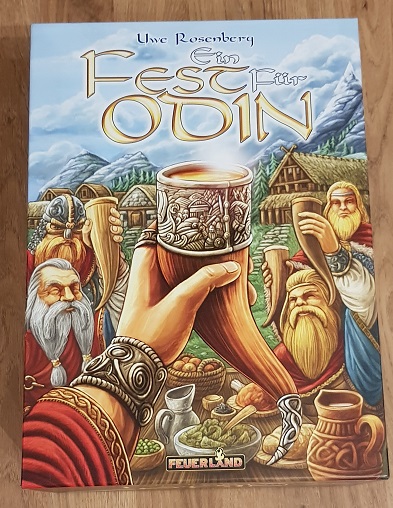
Theme
Northern Europe, approximately 1000 years ago. Even though history remembers the Viking tribes mainly as raiders, pillagers, and plunderers, they were much more than that. First and foremost farmers, fishermen, hunters, traders, and explorers, they resorted to violent ways mainly due to the harshness of their environment.
A Feast for Odin allows you to lead your tribe in any direction you please. You can buy (or build) powerful warships and go on raids, or you can resort to animal breeding, fishing, whaling, hunting, trading, or crafting. Or anything in between.
For a worker placement eurogame, the theme is quite pronounced and connected to the mechanics. For example, when hunting, you need to lower your dice roll to zero, representing the hit points of the animal. On the other side, when attacking, you need to raise this number, increasing your might and ability to plunder.
Feast on this
Your people also need to be fed (that’s the Feast from the title), you can equip ships to make them more effective when whaling, you can explore and colonize new lands, animals get pregnant and breed, occupation cards make thematic sense, and you can immigrate to other lands, making it easier to feed people left behind.
I know, the whole placing of your produced and plundered goods tiles on your home board and exploration boards is a highly abstracted mechanic that can’t be explained thematically. But there is a sense of progress and wealth accumulation provided by it.
The game comes with an extensive almanac written by Gernot Köpke (more on him later), which explains many of the game’s concepts in relation to historical facts. It’s educative, helps understand the design process of the game, and it’s just overall an interesting read and a great bonus addition to the game.
Altogether, I was quite pleased by the atmosphere the game creates. For such a complex strategy game, actions make sense and you feel like you’re doing stuff, not just crunching numbers.
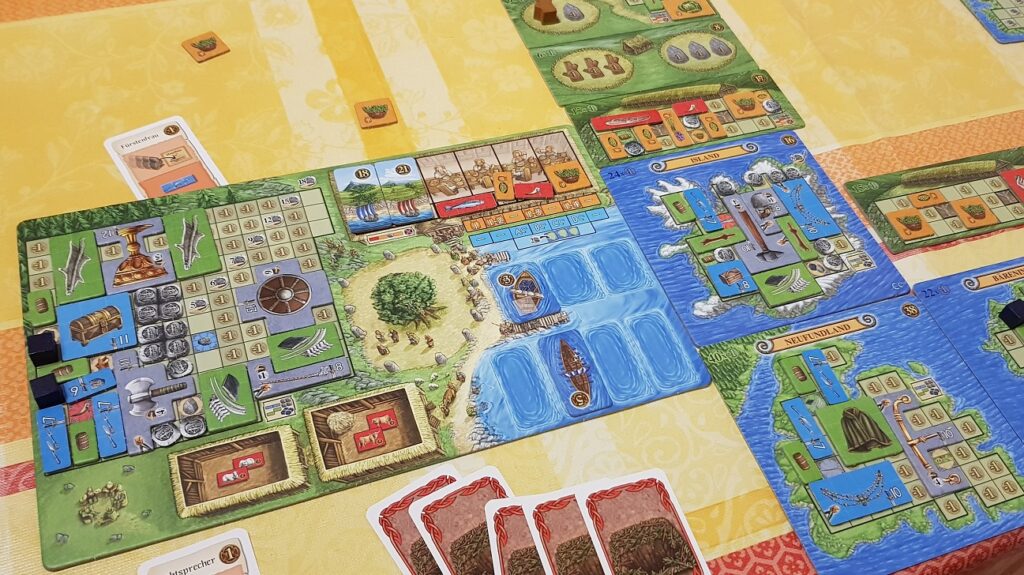
Components and Artwork
The vast majority of the components are goods tiles, that you place on your boards. These are made from thick cardboard, which makes them easy to handle. For the sake of material and space-saving, they are double-sided, with the backside being a resource of the same shape, only of the higher/lower tier.
Two large plastic trays are included, with a specific place for every token, so that handling them during the play is easier. This means handling several hundred goods tokens is relatively straightforward and the setup is not a problem. You just take the plastic trays and you’re ready to go.
Player boards, extension boards, ships, and buildings are also made of thick cardboard and are pretty standard. I haven’t experienced any flex, which is always nice. Cardboard coins are a bit tiny (and they have to be, to be able to fit into 1×1 spaces), but there are larger denominations included, so no problems there, as well.
There are four decks of cards, which are smaller than usual and of decent quality, with a smooth finish on them. For a game that is not primarily a card game, that is more than sufficient.
That only leaves the wooden components: the Viking meeples, wood, ore, and stone. Shortly put, these look great and make the game come alive, although, from a strictly practical point of view, generic cube-shaped wood and stone would be easier to handle. (Yes, I have big, slippery fingers.)
The artwork from Dennis Lohausen with lush green colors creates a cozy atmosphere. I particularly like the pregnant animals’ illustrations as they have their heads pointed at their bellies. To summarize, the presentation is above average and spot-on, both thematically and mechanically.
Rulebook and Learning Process
With its huge table presence, numerous components, and twelve game phases, A Feast for Odin can feel overwhelming at first. But the reality is far from that. The phases help keep the game’s structure, so you always know exactly what is going on. Most of them are only reminders of upkeep which happens after every turn.
It’s the same with action slots. Yes, there are over 60 of them, and in your first game, you’ll be staring at them, not quite knowing where to place your Vikings. But they are logically grouped and many do similar things, only with different costs and intensities.
The rulebook is one of the best I’ve dealt with. It starts with explaining the core game concepts and follows with game phases and the actions. Besides that, there are countless examples, tips, and even a few jokes included. The iconography is clear and easy to understand. This means that once you know the game, you’ll rarely have to look for any clarifications in the rulebook. It just makes sense.
Perhaps most often you’ll look up the clarification on what the occupation cards do, since there’s a lot of them, and often you’ll encounter never-seen-before cards. Although they are for the most part quite clear about what they do, a separate appendix is provided. The cards are numbered, and each has its own explanation in the appendix.
I found the learning process to be one of the smoothest for a game of such scope and complexity. It’s also helpful that the solo mode barely changes any rules from the multiplayer (you don’t have to learn any automa rules or exceptions), and therefore makes it even easier to learn.
Is A Feast for Odin Difficult to Learn and Play?
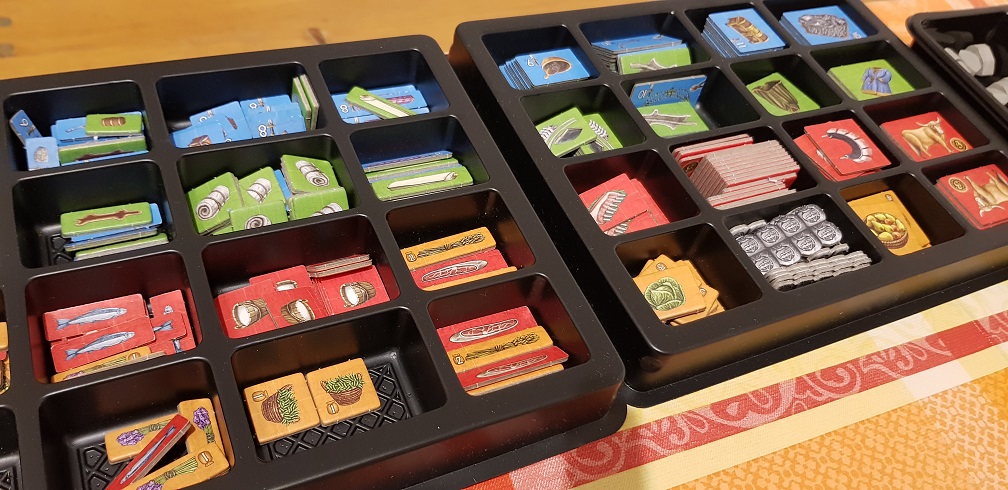
Basic Gameplay Concepts – How To Play A Feast for Odin
The goal of A Feast for Odin is to fill your home board with blue and green tiles, increasing your income and resource production, which means you’ll have resources to buy more boards and houses, and then you can fill those with tiles as well, further increasing your production and scores.
You get points for covering negative point spaces on all those boards, as well as for having ships, animals, or expeditions. It’s a classic engine building where effects compound, starting from your very first move.
You can obtain the tiles as resources during the harvest or hunting, or you can smith them, combine them, breed them, pillage them, buy them, upgrade them, or produce them yourself. Basically, most of the action slots are about gaining and manipulating the tiles.
Action slots
The game is played over 7 rounds, and you get more Viking workers every round. Those Vikings are used to place on action slots during the action phase, the main phase of the game. The slots are categorized into rows of actions that are related: building houses and ships, hunting, managing livestock, producing resources, sailing, occupying new lands.
Furthermore, the actions are divided into four columns. Actions on the first column cost 1 Viking, on the second 2 Vikings, and so on. Therefore, you always have a choice between cheaper and more expensive actions, as well as other related actions. More advanced actions also require certain prerequisites. For example, you’ve got to have a ship ready and equipped if you want to go pillaging.
Placing the tiles onto your boards is a free action that you can do at any time, you can even play with it during your opponents’ turns. But once a tile is placed, it cannot be (re)moved, so think twice.
Another reason to obtain extra exploration boards and houses is bonus spaces on them. These act as another cog in the engine. If you manage to surround them on all 8 sides, you’ll get this bonus (a resource or a tile) every round, which can be a huge boost.
Game structure
After 7 rounds (there’s also a shorter, 6 round variant) the points are tallied up. As said, the rounds are divided into phases:
- taking a new Viking worker from the banquet table,
- harvest food,
- prepare other exploration boards (Shetlands, Faroes, Iceland, and Greenland, among others),
- draw weapon cards,
- place workers and carry out actions,
- determine a new starting player
- calculate income,
- breed animals,
- feast (placing food on the banquet table and feeding your people),
- claim bonuses,
- add new mountain strips for basic resources and
- remove Vikings and prepare for the next round.

Where will you place your workers?
Smooth and Flowing Gameplay
Where A Feast for Odin really shines, is how all those phases and rounds meld into one another. They produce a smooth and flowing experience, where you can immerse yourself into playing and just playing.
The rules are clear and easy to remember, so there’s minimum referencing to them during the game. Since you’re always interested in which action slots other players will occupy, and you can also place your tiles and forge plans out of your turn, downtime is not a problem either.
You know that feeling when after a game, you wonder how the last couple of hours flew by? A Feast for Odin is that game.
Long Term Appeal
Because of the large number of action slots, it’s nigh impossible to use all of them in one game. Therefore, A Feast for Odin is a game of many possibilities. It resembles open-world video games – you can take whichever path you like. Build a fleet of warships and focus your game around raiding, or perhaps utilize a more peaceful strategy and focus on animal breeding.
Both are viable paths to victory, as are hunting, trading, crafting, whaling, and others. There’s a lot to dig through and master and it will take you many games to explore all the strategies. Beginners will have a hard time picking action slots or developing a strategy. So, how do you decide what to do in a certain game?
That’s where the occupation cards and weapons come in. Occupation cards give you special abilities or small bonuses for certain actions, which gently nudges you in a specific direction. So do the weapons. If you draw spear after spear, then that whaling spot will become more and more appealing to you.
Games between experienced players are often decided on whoever squeezes the most points out of the cards he draws. If you’re competitive, you shouldn’t neglect them. To give the game longevity, three thick decks are included, making sure there’ll be a while before you start seeing familiar cards.
Occupation cards, weapons, and dice rolls (besides other unexpected actions, such as what other players do) are also the reason why you can’t keep your strategy set in stone. You need to be flexible and ready to adapt when the game situation changes.
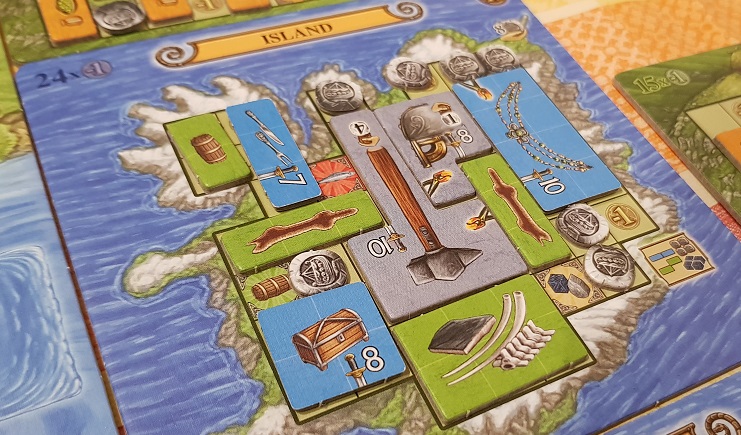
Abundance over scarcity
In contrast to many tight eurogames, A Feast for Odin forces the players to build their strategy on abundance rather than scarcity of resources. Rarely will you run into a situation where you don’t have enough food to feed your Vikings or that you’re one coin short of buying a ship.
There are always enough resources to make something work, and for optimal play, you still need to use them wisely. I think this is a great approach since it’s a lot less frustrating on the players, yet still rewards clever plays.
When using actions that involve weapons (hunting, whaling, pillaging, raiding), the outcome is dictated by a die roll, although you can influence it heavily if you have more weapons. You can even re-roll the die twice, hoping for a better result, which adds a sweet push-your-luck element into the game. Even if you fail, you do get a small consolation prize.
Although I’m normally not a fan of a random element in a heavy strategy game, in A Feast for Odin it feels so natural and non-intrusive, that I can’t wait to roll that die. Of course, you need to be well equipped with weapons and other modifiers before that. It’s still a crapshoot if you come in unprepared.
One thing that we had trouble understanding during the initial games, is where the points actually come from. There’s no partial scoring or a score track, so you don’t exactly know where you are right until the end. After a few games, it becomes more intuitive, and you realize what to focus on for those big points (hint: exploration boards and expeditions). But it can be rough for new players.
Scalability and Solo Mode
The game plays equally well at all player counts from 1 to 4. Unless you’re playing with particularly analysis-paralysis prone players, the downtime is usually not a problem. Often the next player can start his turn before the previous player ends (providing the action slots don’t “clash” or affect each other). An experienced group can work wonders here.
The dynamics also change with different player counts, particularly when it comes to competition for action slots and expedition boards. Not for better or worse, the supply and demand are altered, and the game experience is different.
Particularly interesting is the solo mode. It works extremely well. The rules are more or less unchanged, you just use Vikings of two colors, acting as your own competition for action slot. This changes the meta once more, and even adds another layer of strategy. Should you pillage this turn or leave the space open for the next turn, when the rewards will possibly be greater?
Exploring the different possibilities is also more pronounced, as this is what will differentiate games from one another. It’s recommended to pick starting occupations manually so that you can truly focus your game on one area.
Lack of automa ensures fast gameplay (you can be done in under an hour, including setup) – you compete for a high score. This works surprisingly well. There are no objective cards or round goals, making the end score a measurable milestone against which you can easily compare your other results.
Because of these reasons, I have no hesitations to recommend A Feast for Odin to exclusive solo players.
Why A Feast for Odin is an Excellent Solo Board Game (3 Reasons)
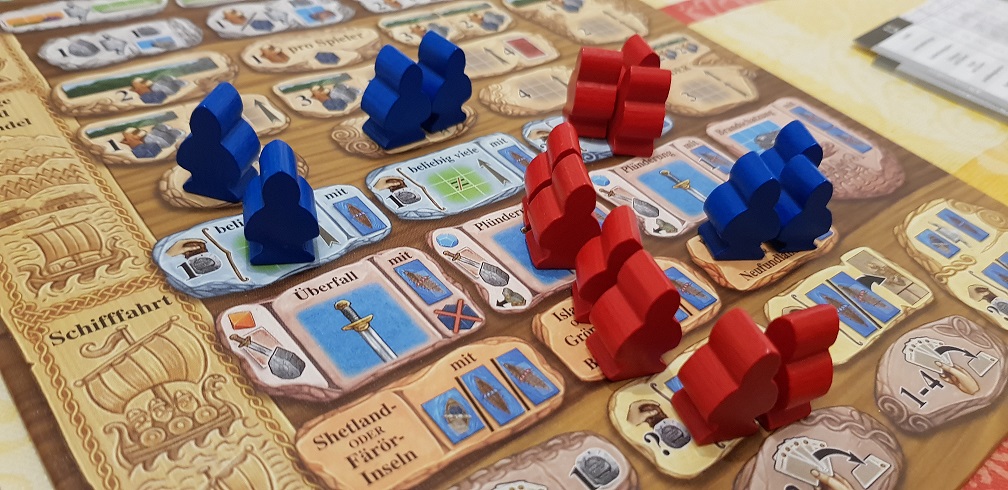
Expansions
If there’s one area where the base game lacks in variability, it’s the expedition boards. There are four double-sided in the base game (the sides of unpicked boards are flipped to a more lucrative side mid-game, pushing players to either pick early or wait out for better boards, risking being left with nothing) and all four are used during every game. Naturally, they get old after a while.
Should You Buy Expansions for a Feast for Odin? – Norwegians and Two Mini Expansions
This is fixed by two mini-expansions, which (besides a few other goodies) add extra islands to explore. Both are designed by the game’s biggest fan, Gernot Köpke (the guy who wrote the almanac). He’s really putting his life into this game, working together with Uwe and other big names in creating Norwegians and the upcoming expansions.
The Norwegians
The Norwegians expansion is a full-scale box. Besides another 4 new islands, it rebalances the action board (not that it was terrible in the first place). This is now modular and designed to work for different player counts. In particular, it reduces the number of available slots for fewer players, making the game even tighter.
Moreover, it features new resource tiles, as well as custom houses, which you pick at the beginning. These help you to further specialize your strategy and increase longevity and variability.
To conclude, all the available expansions are well worth the money, but I wouldn’t rush out to get them right away. The base game has more than enough juice in it to keep you going for a long time. You’ll feel when it’s the right time to add them. If you play only occasionally, perhaps you won’t need them at all.
But Gernot is not done yet. For the coming years, two more expansions are announced, Danes and Swedes. Not much is known, but they promise new features, such as campaigns, asymmetrical starting positions, an explorable map of Eastern Europe, adventure, weather elements, and more.
Conclusion
A Feast for Odin is a fantastic board game. I hate to sound like a fanboy, but I don’t have anything bad to say about it. It’s high on replayability (desire to play again and again), and it’s rightly among the all-time greats.
It’s still going strong in 2022, and with the coming expansions, it doesn’t look like stopping. I can recommend it to anyone. Yes, it’s complex, but it’s easier to learn than you might think. And it has strategic depth like few others. Just make sure you have a large table, as A Feast for Odin is a game that likes to make itself comfortable.
>>>A Feast for Odin is available on Amazon<<<
If you click on an affiliate link, it will take you to the Amazon store. If you then buy something, I will earn a commission – I am a member of the Amazon Associates program, as well as others.
Further reading:



Excellent review, thank you.
Thanks for the kind words, sir.